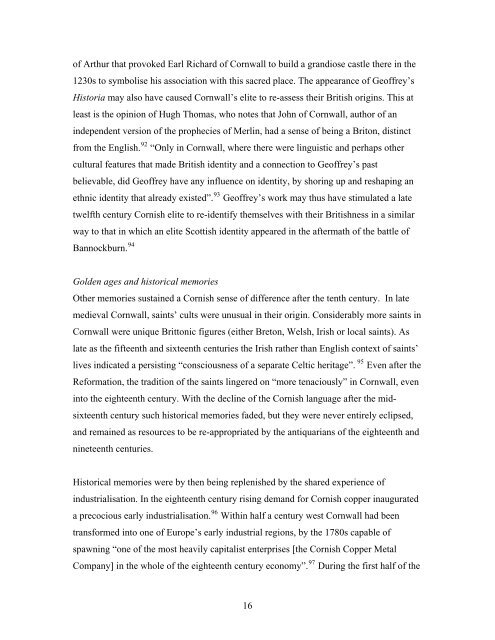Britishness, what it is and what it could be, is now high on both ...
Britishness, what it is and what it could be, is now high on both ...
Britishness, what it is and what it could be, is now high on both ...
Create successful ePaper yourself
Turn your PDF publications into a flip-book with our unique Google optimized e-Paper software.
of Arthur that provoked Earl Richard of Cornwall to build a gr<str<strong>on</strong>g>and</str<strong>on</strong>g>iose castle there in the<br />
1230s to symbol<str<strong>on</strong>g>is</str<strong>on</strong>g>e h<str<strong>on</strong>g>is</str<strong>on</strong>g> associati<strong>on</strong> w<str<strong>on</strong>g>it</str<strong>on</strong>g>h th<str<strong>on</strong>g>is</str<strong>on</strong>g> sacred place. The appearance of Geoffrey’s<br />
H<str<strong>on</strong>g>is</str<strong>on</strong>g>toria may also have caused Cornwall’s el<str<strong>on</strong>g>it</str<strong>on</strong>g>e to re-assess their Br<str<strong>on</strong>g>it</str<strong>on</strong>g><str<strong>on</strong>g>is</str<strong>on</strong>g>h origins. Th<str<strong>on</strong>g>is</str<strong>on</strong>g> at<br />
least <str<strong>on</strong>g>is</str<strong>on</strong>g> the opini<strong>on</strong> of Hugh Thomas, who notes that John of Cornwall, author of an<br />
independent versi<strong>on</strong> of the prophecies of Merlin, had a sense of <str<strong>on</strong>g>be</str<strong>on</strong>g>ing a Br<str<strong>on</strong>g>it</str<strong>on</strong>g><strong>on</strong>, d<str<strong>on</strong>g>is</str<strong>on</strong>g>tinct<br />
from the Engl<str<strong>on</strong>g>is</str<strong>on</strong>g>h. 92 “Only in Cornwall, where there were lingu<str<strong>on</strong>g>is</str<strong>on</strong>g>tic <str<strong>on</strong>g>and</str<strong>on</strong>g> perhaps other<br />
cultural features that made Br<str<strong>on</strong>g>it</str<strong>on</strong>g><str<strong>on</strong>g>is</str<strong>on</strong>g>h ident<str<strong>on</strong>g>it</str<strong>on</strong>g>y <str<strong>on</strong>g>and</str<strong>on</strong>g> a c<strong>on</strong>necti<strong>on</strong> to Geoffrey’s past<br />
<str<strong>on</strong>g>be</str<strong>on</strong>g>lievable, did Geoffrey have any influence <strong>on</strong> ident<str<strong>on</strong>g>it</str<strong>on</strong>g>y, by shoring up <str<strong>on</strong>g>and</str<strong>on</strong>g> reshaping an<br />
ethnic ident<str<strong>on</strong>g>it</str<strong>on</strong>g>y that already ex<str<strong>on</strong>g>is</str<strong>on</strong>g>ted”. 93 Geoffrey’s work may thus have stimulated a late<br />
twelfth century Corn<str<strong>on</strong>g>is</str<strong>on</strong>g>h el<str<strong>on</strong>g>it</str<strong>on</strong>g>e to re-identify themselves w<str<strong>on</strong>g>it</str<strong>on</strong>g>h their <str<strong>on</strong>g>Br<str<strong>on</strong>g>it</str<strong>on</strong>g><str<strong>on</strong>g>is</str<strong>on</strong>g>hness</str<strong>on</strong>g> in a similar<br />
way to that in which an el<str<strong>on</strong>g>it</str<strong>on</strong>g>e Scott<str<strong>on</strong>g>is</str<strong>on</strong>g>h ident<str<strong>on</strong>g>it</str<strong>on</strong>g>y appeared in the aftermath of the battle of<br />
Bannockburn. 94<br />
Golden ages <str<strong>on</strong>g>and</str<strong>on</strong>g> h<str<strong>on</strong>g>is</str<strong>on</strong>g>torical memories<br />
Other memories sustained a Corn<str<strong>on</strong>g>is</str<strong>on</strong>g>h sense of difference after the tenth century. In late<br />
medieval Cornwall, saints’ cults were unusual in their origin. C<strong>on</strong>siderably more saints in<br />
Cornwall were unique Br<str<strong>on</strong>g>it</str<strong>on</strong>g>t<strong>on</strong>ic figures (e<str<strong>on</strong>g>it</str<strong>on</strong>g>her Bret<strong>on</strong>, Welsh, Ir<str<strong>on</strong>g>is</str<strong>on</strong>g>h or local saints). As<br />
late as the fifteenth <str<strong>on</strong>g>and</str<strong>on</strong>g> sixteenth centuries the Ir<str<strong>on</strong>g>is</str<strong>on</strong>g>h rather than Engl<str<strong>on</strong>g>is</str<strong>on</strong>g>h c<strong>on</strong>text of saints’<br />
lives indicated a pers<str<strong>on</strong>g>is</str<strong>on</strong>g>ting “c<strong>on</strong>sciousness of a separate Celtic her<str<strong>on</strong>g>it</str<strong>on</strong>g>age”. 95 Even after the<br />
Reformati<strong>on</strong>, the trad<str<strong>on</strong>g>it</str<strong>on</strong>g>i<strong>on</strong> of the saints lingered <strong>on</strong> “more tenaciously” in Cornwall, even<br />
into the eighteenth century. W<str<strong>on</strong>g>it</str<strong>on</strong>g>h the decline of the Corn<str<strong>on</strong>g>is</str<strong>on</strong>g>h language after the midsixteenth<br />
century such h<str<strong>on</strong>g>is</str<strong>on</strong>g>torical memories faded, but they were never entirely eclipsed,<br />
<str<strong>on</strong>g>and</str<strong>on</strong>g> remained as resources to <str<strong>on</strong>g>be</str<strong>on</strong>g> re-appropriated by the antiquarians of the eighteenth <str<strong>on</strong>g>and</str<strong>on</strong>g><br />
nineteenth centuries.<br />
H<str<strong>on</strong>g>is</str<strong>on</strong>g>torical memories were by then <str<strong>on</strong>g>be</str<strong>on</strong>g>ing replen<str<strong>on</strong>g>is</str<strong>on</strong>g>hed by the shared experience of<br />
industrial<str<strong>on</strong>g>is</str<strong>on</strong>g>ati<strong>on</strong>. In the eighteenth century r<str<strong>on</strong>g>is</str<strong>on</strong>g>ing dem<str<strong>on</strong>g>and</str<strong>on</strong>g> for Corn<str<strong>on</strong>g>is</str<strong>on</strong>g>h copper inaugurated<br />
a precocious early industrial<str<strong>on</strong>g>is</str<strong>on</strong>g>ati<strong>on</strong>. 96 W<str<strong>on</strong>g>it</str<strong>on</strong>g>hin half a century west Cornwall had <str<strong>on</strong>g>be</str<strong>on</strong>g>en<br />
transformed into <strong>on</strong>e of Europe’s early industrial regi<strong>on</strong>s, by the 1780s capable of<br />
spawning “<strong>on</strong>e of the most heavily cap<str<strong>on</strong>g>it</str<strong>on</strong>g>al<str<strong>on</strong>g>is</str<strong>on</strong>g>t enterpr<str<strong>on</strong>g>is</str<strong>on</strong>g>es [the Corn<str<strong>on</strong>g>is</str<strong>on</strong>g>h Copper Metal<br />
Company] in the whole of the eighteenth century ec<strong>on</strong>omy”. 97 During the first half of the<br />
16
















